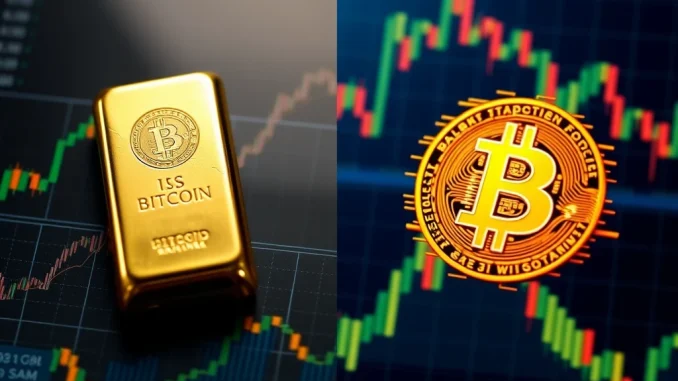
In a surprising turn of events in the cryptocurrency and precious metals markets, gold is currently basking in the glow of strong investor interest, while Bitcoin, the digital gold, is facing headwinds. Are you wondering why gold is suddenly stealing the spotlight? Let’s dive into a recent report by JPMorgan analysts that sheds light on this intriguing divergence.
Unveiling the Surge in Safe-Haven Demand for Gold
According to a report dated April 16 from JPMorgan, the current macroeconomic climate is fueling a significant shift towards safe-haven assets, and gold is emerging as a clear beneficiary. Investors, rattled by global economic uncertainties, are flocking to gold, traditionally seen as a stable store of value during turbulent times. This renewed interest is evident in the substantial inflows into gold investment products.
What exactly does this mean for the gold market?
- ETF Inflows Soar: Global gold ETFs (Exchange Traded Funds) have witnessed a remarkable $21.1 billion in net inflows during the first quarter of 2025. This massive influx of capital indicates strong investor confidence in gold as a safe haven.
- Futures Market Strength: Beyond ETFs, the futures market for gold is also reflecting robust demand. JPMorgan analysts highlighted strong inflows in gold futures, further reinforcing the narrative of gold’s resurgence.
- Macroeconomic Uncertainty as Catalyst: The report emphasizes that this surge in gold demand is primarily driven by prevailing macroeconomic uncertainty. Factors such as inflation concerns, geopolitical tensions, and potential economic slowdowns are prompting investors to seek refuge in gold.
| Asset Class | Q1 2025 Net Flows | Market Sentiment |
|---|---|---|
| Global Gold ETFs | +$21.1 Billion | Strong Inflows (Positive) |
| Bitcoin ETFs | Outflows (for 3 consecutive months) | Outflows (Negative) |
Why is Bitcoin Laggard Despite Safe-Haven Narrative?
While gold is experiencing a resurgence, Bitcoin’s performance tells a different story. Despite often being touted as ‘digital gold’ and a hedge against inflation, Bitcoin is currently lagging behind its traditional counterpart in attracting safe-haven flows. JPMorgan’s report points to some key factors contributing to Bitcoin’s underperformance in this risk-off environment.
What are the challenges Bitcoin is facing?
- Pullback from Futures Traders: Unlike gold, Bitcoin is witnessing a pullback from futures traders. This suggests a decrease in speculative interest and potentially a more cautious approach from investors in the derivatives market.
- ETF Outflows Persist: In stark contrast to gold ETFs, Bitcoin ETFs have experienced outflows for three consecutive months. This continuous outflow indicates a lack of investor confidence in Bitcoin as a safe-haven asset, at least in the current macroeconomic context.
- Risk-On Asset Perception: Despite the ‘digital gold’ narrative, Bitcoin is still largely perceived as a risk-on asset. During times of uncertainty, investors tend to reduce exposure to riskier assets like cryptocurrencies and gravitate towards perceived safe havens like gold.
Decoding Macroeconomic Uncertainty: The Fuel for Gold’s Rally
The term macroeconomic uncertainty is central to understanding the current market dynamics. But what does it really encompass, and how does it drive investors towards gold?
Macroeconomic uncertainty refers to a state of unpredictability and instability in the overall economy. This can stem from various factors, including:
- Inflationary Pressures: Rising inflation erodes the purchasing power of fiat currencies, making assets like gold, which are perceived as inflation hedges, more attractive.
- Geopolitical Instability: Global conflicts, political tensions, and trade wars create economic uncertainty, prompting investors to seek safe havens.
- Economic Slowdowns or Recessions: Fears of economic recessions or slowdowns increase risk aversion, leading to a flight to safety.
- Interest Rate Hikes: While rising interest rates can sometimes be negative for gold (as it doesn’t yield interest), the uncertainty surrounding the pace and impact of rate hikes can also drive safe-haven demand.
In the face of such uncertainties, gold’s historical role as a store of value and its limited supply make it a compelling choice for investors seeking to preserve capital.
ETF Inflows: A Tale of Two Assets – Gold vs. Bitcoin
The contrasting fortunes of gold and Bitcoin ETFs highlight a critical difference in investor sentiment. ETF inflows are a key indicator of institutional and retail investor demand. The significant inflows into gold ETFs and the persistent outflows from Bitcoin ETFs paint a clear picture of current preferences.
Why are gold ETFs attracting so much capital while Bitcoin ETFs are facing outflows?
- Established Track Record: Gold ETFs have a longer history and a well-established track record as a safe and accessible way to invest in gold. Investors are familiar with this asset class and understand its role in portfolio diversification.
- Regulatory Clarity: The regulatory landscape for gold ETFs is generally clearer and more mature compared to Bitcoin ETFs, which are still navigating evolving regulations in many jurisdictions.
- Perceived Risk and Volatility: Bitcoin is still perceived as a more volatile and riskier asset compared to gold. In risk-off environments, investors tend to favor less volatile options like gold.
- Institutional Adoption: While institutional adoption of Bitcoin is growing, gold has a much broader and deeper institutional investor base. Traditional financial institutions often have established allocations to gold in their portfolios.
Actionable Insights: Navigating the Current Market Divergence
So, what are the key takeaways for investors from this analysis?
- Diversification is Key: The current market scenario underscores the importance of diversification. Holding a mix of assets, including both traditional safe havens like gold and growth assets like Bitcoin, can help navigate market volatility.
- Understand Risk Tolerance: Assess your risk tolerance and investment goals. If capital preservation is a priority in the current environment, consider increasing exposure to gold or other safe-haven assets.
- Monitor Macroeconomic Indicators: Stay informed about macroeconomic developments, inflation trends, and geopolitical risks. These factors will continue to influence the performance of both gold and Bitcoin.
- Long-Term Perspective on Bitcoin: While Bitcoin is currently lagging, it remains a potentially high-growth asset in the long term. Short-term underperformance in risk-off periods does not negate its long-term potential.
Conclusion: Gold’s Shine Brightens Amidst Economic Storm Clouds
The report from JPMorgan analysts highlights a fascinating dynamic in the current market – gold’s resurgence as a premier safe-haven asset, while Bitcoin grapples with headwinds. The strong safe-haven demand for gold, fueled by macroeconomic uncertainty and reflected in significant ETF inflows, contrasts sharply with Bitcoin’s recent struggles. While Bitcoin’s long-term narrative remains compelling, in times of heightened risk aversion, traditional safe havens like gold continue to hold sway. Investors should carefully consider these trends and adjust their strategies to navigate the evolving landscape of both cryptocurrency and precious metals markets.



